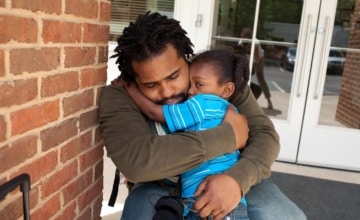Though we often think of consent as a topic for the teenage years, we can build this understanding much earlier.
Have you seen the video of the preschool kids greeting each other as the school day begins? Each child gets a high five, a fist bump, a handshake, or a hug. Their choice. Here’s why that choice matters.
Think back to family visits when you were young. Chances are good a parent nudged you forward, insisting you “Give [name of relative] a hug.” There might have been an awkward moment. You may have hesitated because your distant relative had scratchy whiskers or smelled funny or you just didn’t know them very well. Back then, many families saw this hug-and-kiss ritual as a natural part of holidays or visits. Turns out there are some good reasons to take a close look at this tradition and challenge the idea that children should be told who to touch and when.
Experts now see these early encounters as an opportunity to teach children about body autonomy and consent. Though we often think of consent as a topic for the teenage years, we can build this understanding much earlier. Body autonomy is the idea that your body belongs to you and you are in charge of it. This is an empowering message that helps children protect themselves from unwanted touch at any age.
Here are some ways you can teach toddlers that their body is theirs and theirs alone.
- Model respect. Even before your child knows how to talk, you can honor their body autonomy by letting them know what you are doing before you do it: “I’m going to take your diaper off and wipe your bottom now.”
- Teach that each body part has a name. We teach children the correct names for their heads, shoulders, knees, and toes. But we’re often less straightforward about “boy parts” and “girl parts.” (At least that’s the way it was in my family!) When we use and model the correct names for vaginas and vulvas, penises and testicles, we give children the ability to talk about health issues without embarrassment. We also give them the words to report inappropriate touch if they ever should experience it.
- Teach that no means no. Teach children that you’ll listen to their wishes when they don’t want to be tickled, kissed, hugged, or tossed in the air. Practice having them say “no” and “stop” and respond appropriately. Teach that they should stop tickling, touching, or teasing when someone else says “no” or “stop.”
Of course, toddlers can’t make all the decisions, and there are many situations when a decision isn’t theirs to make. They get washed in the tub, wiped during diaper changes, buckled into car seats, snapped into snowsuits, and tucked into bed. It helps to give children some choices during these moments: “I hear that you don’t want your hair washed. We need to get your hair clean. Would you like to hold the washcloth over your eyes?” When it comes to touch, children should know as early as possible that they can make choices about how they are touched and by whom.
Be clear and confident that children have a choice about touch. There will be the moment when a beloved Aunt Louise can’t wait to wrap a little one in a big bear hug and the child is not. on. board. It can help to think about what to say ahead of time — “Chloe needs some time to warm up. Let’s save hugs and kisses for later.” Or offer the child a choice so it’s clear that they get to decide what works for them — “How would you like to say good-bye to Grandma? Do you want to wave or give her a hug?”
Teach cultural traditions. Different cultures may have a routine way of saying hello and goodbye — a bow to an elder or a kiss on each cheek. Explain how you greet each other in your family. “In our family, we give each other a kiss on the cheek to say hello and goodbye.” Most children soon want to copy what their parents do — all on their own without prompting.





